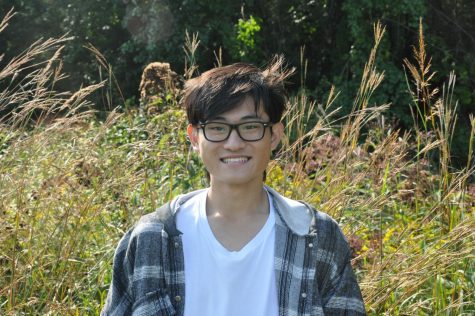Opinion: ‘Avatar: the Last Airbender’ is the best children’s cartoon
Credit: Credit: Flickr user Net Sama
WSPN’s Brasen Chi celebrates the 15th anniversary of “Avatar: The Last Airbender.”
March 11, 2020
With the 15th year anniversary of “Avatar: the Last Airbender” having recently passed on Feb. 21, I believed that this masterful show deserved to be remembered.
For the uncultured, “The Last Airbender” revolves around a world with four nations, each represented by the element that its people can control, or “bend.” This world became plagued by war when the Fire Nation began to invade other nations. The only person that could possibly stop the growing threat of the Fire Nation’s power and growing territory was the Avatar, a bender who could control all four elements. However, the previous Avatar vanished, and the world was left by itself for over 100 years until a female waterbender, Katara, and her non-bender brother, Sokka, stumble upon the new Avatar, an airbender named Aang. Aang is just a child, but now, he has the weight of the world on his shoulders.
Now the plot is very generic: there’s a chosen one that has to save the world from impending doom. It’s mirrored in Harry Potter, Lord of the Rings and the list goes on and on. The question is, why does “Avatar: the Last Airbender” stand out? Well, for starters, the world-building is absolutely phenomenal. Personally, the merging of eastern and western cultures particularly stands out. Many of the names are heavily influenced by East Asia. Not only that, but the clothing and main continent is clearly based on Asia and Asian culture. There isn’t enough exposure of eastern culture in the West. There are dragons and spirits all based on East Asian culture. Unlike European dragons, with the giant wings and four legs, dragons in “Avatar: the Last Airbender” have dragons that are thin, more serpent-like. The spirits all have Chinese names. The moon spirit is named Yue, which is also the Chinese word for the moon. There is also a panda spirit named Hei Bai, which means black and white in Chinese. The merging of cultures is the first thing that attracted me to this incredible show.
The depth of the characters make the show so much better. My favorite, and most of the audience’s, is Zuko, crown prince to the Fire Nation. In the story, he eventually switches from the main antagonist in season one into one of the Aang and buddies in season three – however, as the plot builds up, it makes sense as to why he switched. Zuko’s thought process and wavering trust in the Fire Nation’s actions are expressed in his interactions with Uncle Iroh (another of my favorite characters). His journey is one of self-acceptance: he constantly tries to prove himself in the eyes of his father, but he eventually learns that honor is something that is earned by doing what’s right. Because of this revelation, he joins team Avatar in an attempt to right the wrongs of the Fire Nation. Of course, this is just the basics of his development, but as the show continues, Zuko truly does become one of (if not) the most beloved character.
“Avatar: the Last Airbender” has stayed relevant because of how ahead of its time it was. The show’s main message seems to be one of inclusion and how someone lacking in certain places doesn’t mean that they aren’t important. The examples of this are endless with Sokka being just one of them. There’s Toph, the world’s greatest earthbender, who was sheltered by her doting parents because she was blind. They don’t trust Toph to care for herself even though she can “see” through the vibrations in the ground. There’s also Teo, another earthbender, who is paralyzed from the waist down. Of course, he’s still perfectly capable of movement by using his glider. He even outclasses Aang in aerial acrobatics. These “disabled” characters go against all odds and even surpass those who aren’t.
I consider “Avatar: the Last Airbender” to be the best children’s cartoon. The aforementioned reasons are just a couple of examples, but the list goes on and on. I could write more about the amazing plot progression, how the characters all have their own proper development throughout the show, the criticism of imperialism and even the moral and ethical questions asked. I believe “Avatar: the Last Airbender” stands as not only one of the best children’s cartoons, but just one of the best cartoons in general.
Opinion articles written by staff members represent their personal views. The opinions expressed do not necessarily represent WSPN as a publication.





![Last Wednesday, the Wayland School Committee gathered to discuss a number of topics regarding the health curriculum and Innovation Career Pathway course. Another large topic of conversation was the ways to potentially mitigate distracting cell phone usage. "These [phones] are going to distract your learning and social relationships," Superintendent David Fleishman said. "That's concrete right there."](https://waylandstudentpress.com/wp-content/uploads/2025/06/Screenshot-2025-06-04-at-9.49.31 PM-1200x886.png)



























![Troy Hoyt finishes the Boston Marathon, running for the Hoyt Foundation. T. Hoyt is the son of Hoyt Foundation CEO Russ Hoyt.
“[Running a marathon] might seem like a big thing, when it’s presented to you at first, but if you break it up and just keep telling yourself, “Yes, you can,” you can start chipping away at it. And before you know it, you’ll be running the whole 26 miles, and you won’t even think twice about it.” T. Hoyt said.](https://waylandstudentpress.com/wp-content/uploads/2025/04/C36E8761-1CBB-452E-9DF2-543EF7B1095E_1_105_c.jpeg)












































